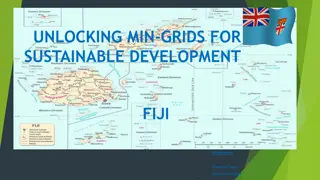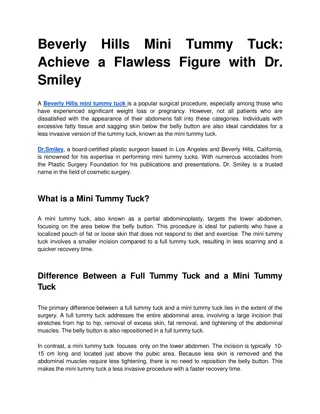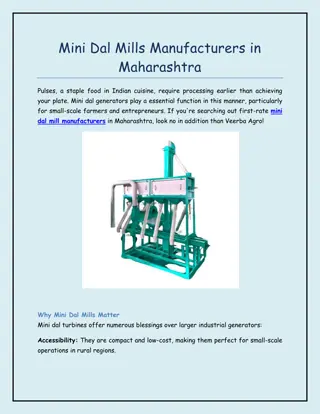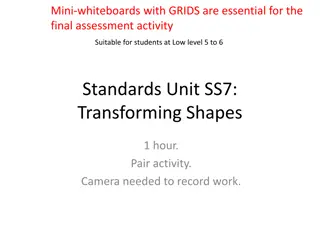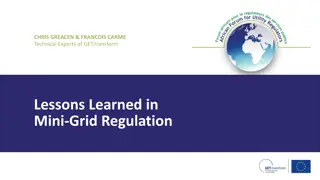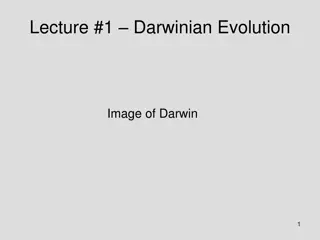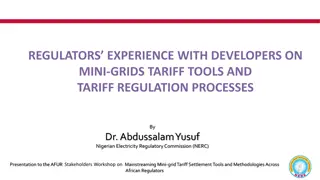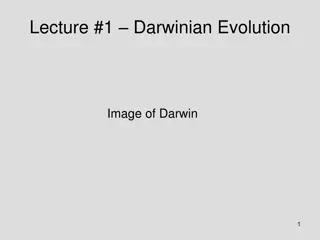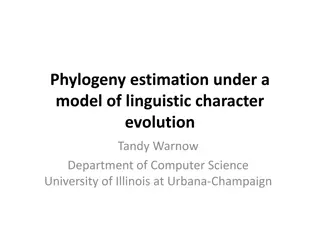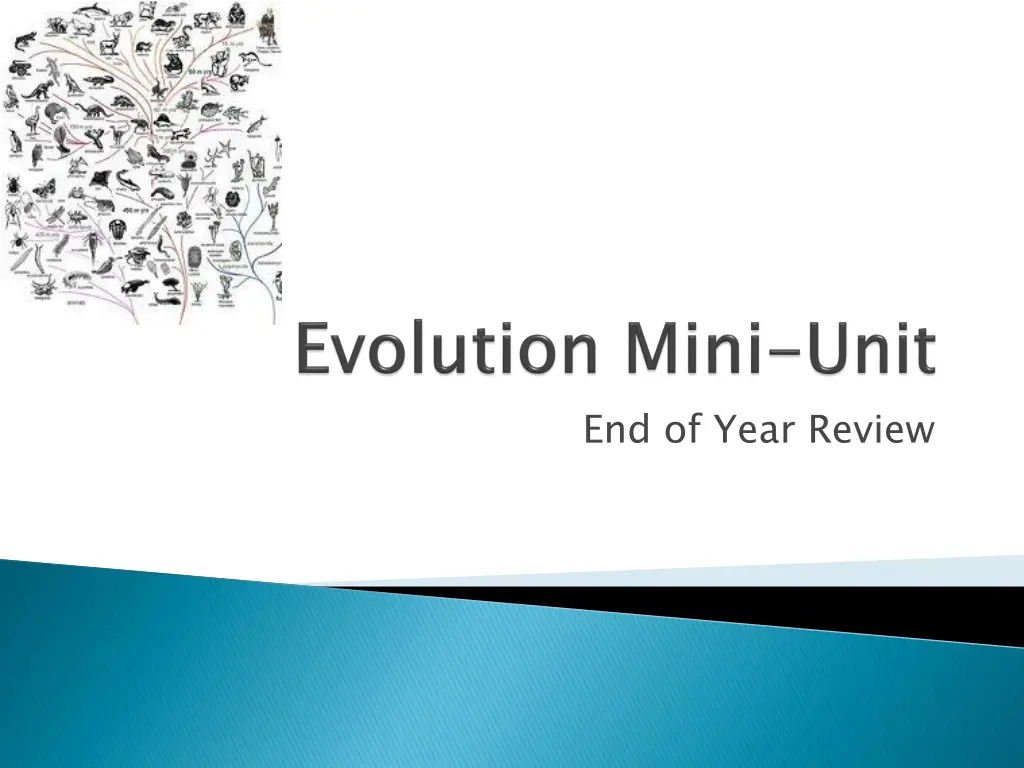
Overview of Life's Origins and Evolution
Explore the fascinating journey of life on Earth, from its humble beginnings over 3 billion years ago to the development of complex organisms. Discover how simple single-celled organisms evolved into the diverse life forms we see today. Delve into the formation of the Earth, the emergence of essential compounds, and the transition to aerobic respiration. Uncover the significance of mitochondria and chloroplasts in eukaryotic cells. Ultimately, grasp the central theme of modern biology, illustrating how competition among individuals drives species-wide changes.
Download Presentation

Please find below an Image/Link to download the presentation.
The content on the website is provided AS IS for your information and personal use only. It may not be sold, licensed, or shared on other websites without obtaining consent from the author. If you encounter any issues during the download, it is possible that the publisher has removed the file from their server.
You are allowed to download the files provided on this website for personal or commercial use, subject to the condition that they are used lawfully. All files are the property of their respective owners.
The content on the website is provided AS IS for your information and personal use only. It may not be sold, licensed, or shared on other websites without obtaining consent from the author.
E N D
Presentation Transcript
Life on earth began more than 3 ____________ years ago Fossils have given us many clues to the kind of life that was around The first organisms were simple, ___________- celled organisms Then more complex creatures began to appear The idea that attempts to explain this change = _________________
Formation of the Earth Big Bang Theory Gases condensing _____________________forming Water vapor was in the atmosphere Temperatures _____________ Water vapor condenses and rain falls Oceans formed The tale of life on earth is told through _________ Formation: Organisms dies It is buried Organic material is dissolved and lost Space fills in with mineral deposits
4 major developments Simple ___________________compounds important to life must have formed (amino acids) Formation of complex organic compounds (_________________) Concentration of the compounds Development of links between chemical reactions of growth, metabolism, and ________________________ Can no longer occur because we have oxygen
The first life forms are thought to be _____________ These first life forms probably: Were heterotrophs; Had to get __________from their surroundings Used the food through glycolysis or similar process Through competition for food __________________developed Chemosynthesis occurred first, then photosynthesis That produced _______________as a waste product Destroyed many enzymes but gave rise to aerobic respiration _________________respiration results from reactions used to trap free oxygen
_________________________ mitochondria and chloroplasts are through to have entered eukaryotes for protection and happened to perform a function within them
The central theme for modern biology Helps us understand how the ________________ among individuals leads to changes in an entire species ______________________= first to suggest the idea Since then more evidence has been collected It is now considered a ______________ Theory = concept that has been tested and confirmed in many ways and can be used in predictions https://www.youtube.com/watch?v=92oHNd8vFwo&list=PL8dPuuaLjXtMczXZUmjb3mZSU1Ro xnrey&index=5
Helps biologists understand the similarities among organisms Similarities in bone structure or biochemistry Helps to explain the _______________of life Based on: ___________record Common _______________ Homologous structures Vestigial structures
Fossil record = collection of fossils providing clues to the history of earth and its organisms Spans much of _______________ time billions of years in earth s history Fossils lower in the ground are __________organisms Younger fossils are on the top Scientists can determine a fossils age based on: Position in sediment lower ones are older Carbon dating using isotopes: ____________ and ____________ C-14 is unstable and breaks down over time into C-12 is stable and more common By comparing the amount of C-14 and C-12 we can estimate an age of the fossil.
Evolution does NOT necessarily produce long-term changes in a certain direction Evolutionary change is more like the growth of a __________ It can branch out in different directions to survive; Some die all together with no branching; Other branches continue to branch out and form new species These changes over time are represented through _____________________trees They show common ______________________and what species are still present today The bottom is the ______________________________________of each As you move up the tree more species develop The end of each branch shows the most recent species The branches that are still growing are currently living species Those that have stopped growing are now ___________________ https://www.youtube.com/watch?v=UPgg kvB9_dc
Spontaneous Generation was a theory believed once It was the idea that living things come from nonliving things Redi- Fly and ___________________Experiment Flies were thought to come from dead meat Spallanzani bacteria and ________________experiment Microorganisms were thought to come from the air Pasteur cleared up Spallanzani s experiment and in doing so caused the theory of spontaneous generation to be __________________/disappear The theory of ________________________replaced it Biogenesis is the theory that all living organisms must come from other living organisms
Darwin didnt just suggest evolution He also suggested how things evolved He thought it was similar to ____________ ____________ that breeders participate in Artificial selection = purposefully breed organisms for certain traits He used the idea of _________________ selection to indicate evolution was controlled by nature Individuals that survive are able to pass on their genes to the next generation
In any environment, an individual may be born with characteristics that make them stronger, _____________, or give it an advantage to being able to ___________________ The individuals that are best adapted to their environment will pass on their traits Eventually, these useful traits will be more ___________ Each generation passing it on Traits that decrease an individuals chances of reproducing will decrease As these traits become more common (or less common) = _____________________
The ___________________ changes over time, not the individuals themselves Each individual is born with genetic information but it does not change over time The population may change to show more beneficial traits more often Failure to adapt = ____________ __________________ when an entire species fails to survive a change in their environment No longer exists anywhere on the planet Extirpation when a species fails to survive a change in their environment within a geographical location
Evolution is powered by interactions between the ____________________and organisms Conditions that make evolution a vital process ______________________=population to increase in size Finite (____________) resources Genetic differences in offspring due to _______________ and genetic shuffling The selection of offspring better able to survive and reproduce
A species has the potential to produce more offspring than can could possibly survive. Species that reproduce quickly = ___________________, insects, dandelions, rabbits If all the offspring of these species survived the earth would be overrun The population of a species should remain about the same form year to year. Each year 100 deer may be born but there are still the same amount of deer present as there were the year before. Not all individuals will survive till the next year/ adulthood
Overproduction leads to _______________ among members of a species Not all members survive long enough to ___________ To determine which offspring will survive is often left to chance (Where it is born) There are factors that can help to determine which offspring survive and which will die Offspring need to be able to survive _______________ conditions Temperature, disease, parasites, predators Need of _________________ Water, food, oxygen, shelter
Resources are ______________ Organisms must compete for the resources If the organisms is a successful competitor, it will have the resources it needs to survive Many organisms will not be successful competitors and will perish before they can reproduce
New traits can lead to _____________ within a species Organisms within a species are never exactly alike These differences are due to ___________________ variation Unique combination of traits from parents
If all members of a species were exactly alike, an environmental change could be disastrous Genetic variations gives a chance that some of the members of the species would survive an environmental change _________________ species may not have enough genetic variation required to survive even a slight change in their environment Change is related to the change in the environment Species with high rates of __________________ and short reproduction cycles evolve quicker Failure to adapt = death
_________________ environments results in stable species Horseshoe crab A changing environment results in a changing species Horse ___________________due to antibiotics Insects due to pesticides
Some variations give an individual an advantage over another A trait that helps an organism survive and reproduce under a given set of environmental conditions has ________________value The ability for a rabbit to blend in with its surroundings will let it escape a fox
As Darwin said with natural selection, an organism with adaptive value has an advantage If the beneficial trait is passed on to the offspring, they will be likely to _______________ and reproduce The proportion of individuals with this trait will increase with time Some evolution may occur without much change in the environment Most of the time there is an _________________of the species to changes in the environment A changing environment leads to evolution
The arrangement of DNA bases determines a persons ______________________ Any change in bases or their order can change a characteristic Only changes in a sex cell can be passed on to the next generation This is the basis for evolution Changes in ______________ cells cannot be passed on Example: a man gets muscles from exercise, his kids do not automatically inherit his muscles
There are two major ways an organism can wind up with genes that differ from those of it s parents Some are due to _______________in the genes Others are due to genetic _________________ Genetic shuffling = sorting and recombining genes during ___________________ reproduction
A mutation is a change in the base pairs of DNA They are _______________and cannot be predicted Some mutations occur as __________in DNA Radiation and some chemicals can cause mutations Mutations are an important source of totally new forms of genes A mutation in a _____-cellular organism or in a sex cell of a _______-cellular organism can be passed on When mutations occur in body cells, it only affects that cell
Some mutations can ___________the individual Increase it s chances of surviving, reproducing, and passing the __________________along This could lead to the creation of a new __________________ Example: ancestors of polar bears probably had brown fur but white fur was beneficial
Sorting and random recombining of genes during ______________and fertilization results in a new and different combination of genes These genes can be passed on Mutations are a big source of evolution but genetic shuffling is the main source of variation in _____________reproduction
Changes from mutations or genetic shuffling in sex cells may affect the offspring in many ways Most changes can be categorized as structural, functional, or behavioral
The structure of an organism is the result of an entire _________________ history There are millions of examples that results in structural changes Example: a __________ bear has thick fur to keep it warm (like most bears) but they also have thick fur on their feet to keep them warm and improves traction The ____________ of animals have evolved from a similar structure. Example: humans have a long thick bone, two thinner bones and then a hand. Birds have a thick bone, two thinner bones, and what looks like 2 digits. Whales and bats are all similar
Some modern organisms give clues to their ___________________ Example: some snakes have tiny, nonfunctional leg bones This suggests that they probably evolved from four-legged, _______________like ancestors
Molecular or biochemical changes affect how an organism works Example: working muscles emit an electrical pulse, in some eels the pulse is amplified and can __________ or kill prey Changes in DNA Example: a change in a uni-cellular organisms can now produce an enzyme that digests wood Example: some snakes make _______________
A lot of the behaviors we see today have evolved to help with __________________ success Example: fighting between walrus s for groups of females is evolved. Because the winner is a stronger and healthier mate Example: the rate of blinking allows males and females of firefly species to find each other A different rate would isolate that individual from potential mates
If environmental conditions _______________, organisms that cannot adapt to those conditions may die If all the organisms in a species had the same characteristics and there was an environmental change it could kill them all If there is ____________________, some will survive Once a species characteristics has died off, it will not come back _________________________species worry scientists because their numbers are so small, they may not survive environmental change
Evolution seems to follows patters that appear repeatedly in the ____________record Changes in species are related to environmental change Species with short reproductive cycles produce many offspring and tend to evolve more quickly than species with ________ lifespans and _________ offspring The failure to adapt to a changing environment may result in the death of the ________________
Most of the life on earth is believed to be the result of natural selection The amount of change seems to be linked to _________ and environmental changes The more _____________ the environment, the less evolution It may take millions of years for the changes to classify it as a new __________________
The rate may be influenced by the number of __________________ produced by the species Organisms that have few offspring, live longer so they don t change as much Organisms that have short lives produce more rapidly and change quickly Example: antibiotic resistant bacteria. Those that will not be killed by antibiotics will continue to live and reproduce Example: Insects produce many offspring and have short reproductive cycles. If a pesticide is used, some may have resistance and live on after it s use to reproduce, increasing the population of that resistant insect
Extinction = disappearance of an entire species This happens when death rate is higher than _______ rate Generally happens when the environment changes Temperature change, ________ levels rise or fall, grasslands become deserts, pollution. Variations in organisms can help the organism survive but if they cannot _________, they may become extinct
Any trait that helps an organism to __________ and reproduce under a given set of environmental conditions Rabbits fur or moth ____________ may allow them to blend in with the surroundings allowing them to escape capture from a predator Those that do not posses these beneficial traits have a ______________ chance of being removed from the population
_________________evolution 2 related species becoming more and more dissimilar _________________evolution unrelated species becoming more and more alike in appearance as they adapt to similar environments __________________ change of 2 or more species in close interaction hummingbirds and the flowers that they pollinate
Homologous _____________________ common anatomical structures or embryological similar structures Bat wings, whale flippers, bird wing, human arm and hand, alligator foot _____________________Organs functionless parts of organisms Tail bone in humans, leg bone in snakes, eyes of blind fish, pelvis bones in whales Normally thought to have a purpose in a related species but has no purpose in the current species
____________________________development embryos if different species develop almost identically Especially true in the early stages of development Common ________________= common DNA Blood proteins are shared by multiple species Muscle proteins are also shared by more than one species Analogous Structures structures that are similar in ___________________but not share physiological traits Bird wings have bones, moth wings do not
Lamarck came before _____________, but was missing some pieces and more importantly he was missing required ___________________ Larmarck said that traits developed by living organisms were passed down to the offspring Darwin put the pieces together and said that it was _______________________traits not acquired traits that were passed on


